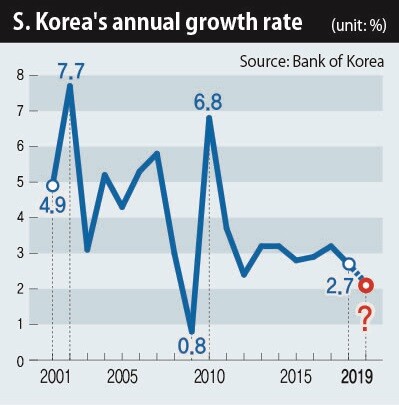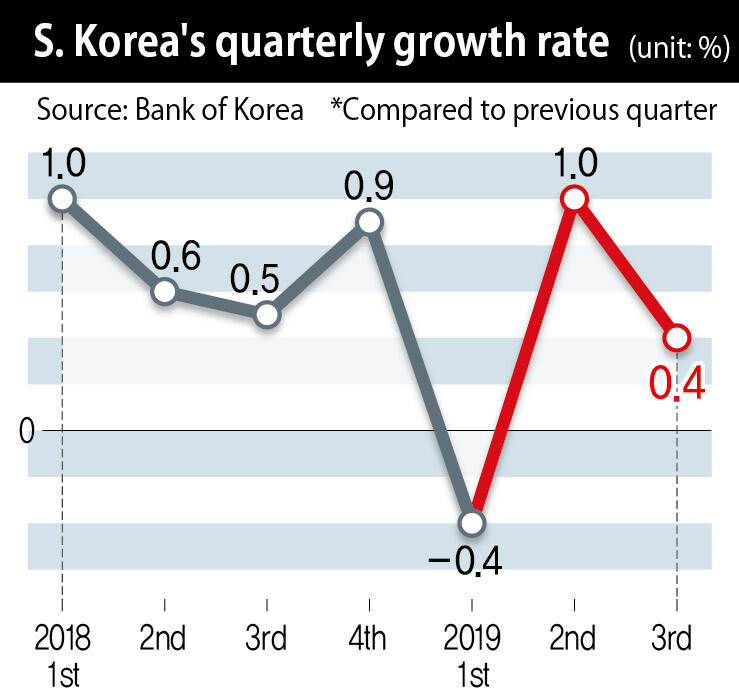hankyoreh
Links to other country sites 다른 나라 사이트 링크
Clearing 2% mark is more or less out of the question for S. Korea’s 2019 growth

In an economic forecast last July, the Bank of Korea (BOK) predicted South Korea’s economic growth would remain at around 1.9% for the first half of 2019 but rise to 2.4% for the second half, for an annual economic growth rate of 2.2%. But with third-quarter growth standing at just 2% from the same period in 2018, clearing the 2% mark is appearing more or less out of the question, let alone living up to the 2.2% projection.
Although the South Korean economy’s estimated potential growth rate was so much higher in the past than its current level of 2.5-2.6%, which makes a direct comparison unfeasible, the national growth rate has only fallen below 2% once since the 2000s, registering at 0.8% in 2009 in the wake of the global financial crisis triggered in the US. In that sense, a growth rate below 2% could have a negative psychological impact on economic
actors.
The economic recovery in the third quarter did not live up to expectations. Many complicating factors have arisen: trade frictions between the US and China have intensified, and the South Korea-Japan trade row continues. The third-quarter growth rate was up by 0.4%, a much smaller rise than the 1.0% one between the first and second quarters. Expanding the rate by another place beyond the decimal point puts it at 0.37%.

A breakdown of third-quarter gross domestic product (GDP) by area showed both construction and facility investment stuck in the minus column with respective growth rates of -3.0% and -2.7% compared to the same period in 2018. Third-quarter exports were up 4.1% from the previous quarter, but the rate of increase compared to the third quarter in 2018 stood at just 1.3%. Private consumption has also been slack, with an increase of just 1.7% from the third quarter last year.
Growth during the second quarter -- which was up 1.0% from the first -- was propelled by the government sector, which made a growth contribution of 1.2 percentage points. During the third quarter, the government sector’s growth contribution was just 0.2 percentage points.
During a parliamentary audit, Deputy Prime Minister and Minister of Economy and Finance Hong Nam-ki predicted, “We can achieve 2% growth for the year if fourth-quarter GDP rises by around 0.97% from the previous quarter.” But current economic conditions and financial resources suggest attaining that high a fourth-quarter growth rate is unlikely. Over 20 quarters in the past five years, the growth rate from one quarter to the next has exceeded 1% just five times.
“The growth rate between the third and fourth quarters should be upwards of 0.4%, but it’s unlikely to reach as high as 1%,” said Chang Min, a senior research fellow at the Korea Institute of Finance. “A 2% growth rate for the year is pretty much out of the question.” In a report published the same day, the Hyundai Research Institute similarly predicted a “strong possibility that the annual growth rate will fall in the 1-2% range.”
The difference between a 2.0% growth rate and a 1.9% growth rate amounts to around 1.8 trillion won (US$1.53 billion) in GDP terms. The impact of a 0.1-percentage point difference in growth rates on individual South Korean lives is not especially large. For this reason, some are saying that even if the 2% mark is reached, the question of what variables lead to that mark is crucial.
“I don’t see it as impossible to increase production by 1.8 trillion won,” said Kim Sung-tae, director of the economic forecasting office at the Korea Development Institute (KDI).
“More important than growth rate figures is whether we see some hopeful signals that the economy is poised to improve during the fourth quarter,” Kim added.
By Jeong Nam-ku, staff reporter
Please direct comments or questions to [english@hani.co.kr]

Editorial・opinion
![[Column] Season 2 of special prosecutor probe may be coming to Korea soon [Column] Season 2 of special prosecutor probe may be coming to Korea soon](https://flexible.img.hani.co.kr/flexible/normal/500/300/imgdb/original/2024/0426/3317141030699447.jpg) [Column] Season 2 of special prosecutor probe may be coming to Korea soon
[Column] Season 2 of special prosecutor probe may be coming to Korea soon![[Column] Park Geun-hye déjà vu in Yoon Suk-yeol [Column] Park Geun-hye déjà vu in Yoon Suk-yeol](https://flexible.img.hani.co.kr/flexible/normal/500/300/imgdb/original/2024/0424/651713945113788.jpg) [Column] Park Geun-hye déjà vu in Yoon Suk-yeol
[Column] Park Geun-hye déjà vu in Yoon Suk-yeol- [Editorial] New weight of N. Korea’s nuclear threats makes dialogue all the more urgent
- [Guest essay] The real reason Korea’s new right wants to dub Rhee a founding father
- [Column] ‘Choson’: Is it time we start referring to N. Korea in its own terms?
- [Editorial] Japan’s rewriting of history with Korea has gone too far
- [Column] The president’s questionable capacity for dialogue
- [Column] Are chaebol firms just pizza pies for families to divvy up as they please?
- [Column] Has Korea, too, crossed the Rubicon on China?
- [Correspondent’s column] In Japan’s alliance with US, echoes of its past alliances with UK
Most viewed articles
- 1Is Japan about to snatch control of Line messenger from Korea’s Naver?
- 2[News analysis] Using lure of fame, K-entertainment agency bigwigs sexually prey on young trainees
- 3[Column] Park Geun-hye déjà vu in Yoon Suk-yeol
- 4Will NewJeans end up collateral damage in internal feud at K-pop juggernaut Hybe?
- 5‘We must say no’: Seoul defense chief on Korean, USFK involvement in hypothetical Taiwan crisis
- 6[Column] The clock is ticking for Korea’s first lady
- 7[Column] Season 2 of special prosecutor probe may be coming to Korea soon
- 8Korea’s 1.3% growth in Q1 signals ‘textbook’ return to growth, says government
- 9Division commander ordered troops to enter raging flood waters before Marine died, survivor says
- 10Report reveals toxic pollution at numerous USFK bases